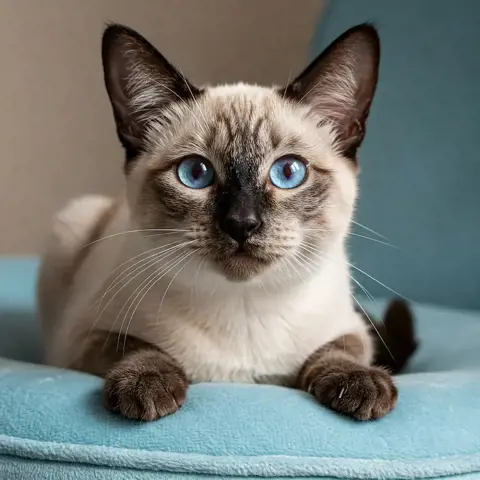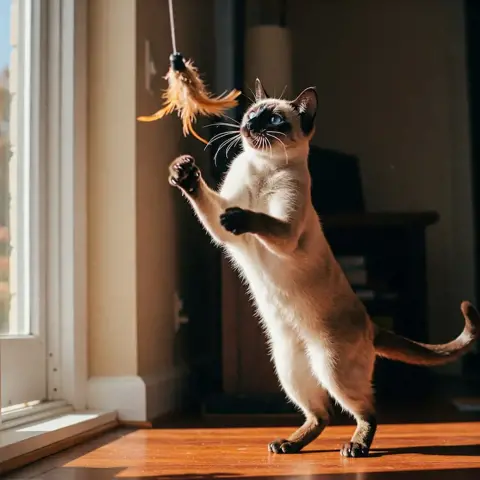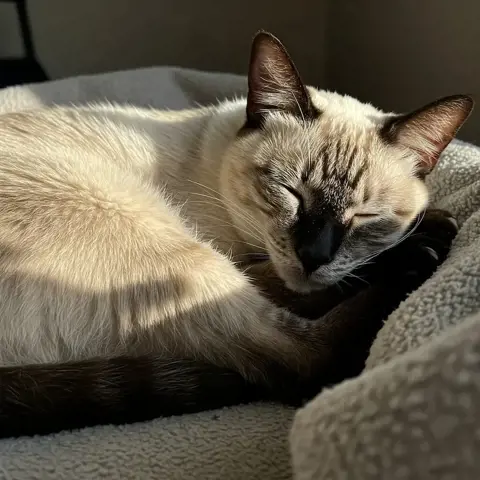Why Are Siamese Cats Cross Eyed? Genetics, Health, and Care Guide

In This Article
Why Are Siamese Cats Cross Eyed? The BasicsGenetics and Eye Structure in Siamese Cats
Health Concerns and Daily Life With Crossed Eyes
Caring for a Cross Eyed Siamese Cat
Common Myths, History, and Frequently Asked Questions
Conclusion
Ever wonder why Siamese cats are often seen with those signature crossed eyes? It’s not just a quirky look—there’s real science behind it. If you’ve found yourself asking, “why are Siamese cats cross eyed?” or worrying, “is it normal for Siamese cats to be cross eyed?” you’re not alone.
Curiosity and concern are common for Siamese cat owners seeing this trait for the first time. Not all Siamese cats have crossed eyes these days, but it’s still a recognizable part of the breed’s history. In this post, you’ll get clear answers about the genetics behind their unique vision, what percentage of Siamese cats are cross eyed today, and whether crossed eyes impact their health or daily life. You’ll also pick up straightforward advice on care, learn about common myths, and get the facts you need to help your Siamese thrive.
If feline quirks like why cats stick their tongues out make you smile, you’re in the right place. Let’s make sense of those mysterious peepers together.
Why Are Siamese Cats Cross Eyed? The Basics
Siamese cats are famous for their striking blue eyes, beautiful coats, and those unmistakable crossed eyes. Seeing this trait for the first time can be a whimsical surprise. You may wonder if all Siamese cats look this way or if it’s a sign of something odd. Let’s break down why some Siamese cats have this curious look and what it means for your pet.

Siamese Cat Crossed Eyes Explained
When people ask “why are Siamese cats cross eyed,” they’re seeing a classic part of this breed’s appearance—something called strabismus. Strabismus is just a term for eyes that don’t point in the same direction. Most often, you’ll notice both eyes angled toward the nose, creating that famous cross-eyed look.
But why does this happen? The answer lies in the wiring of their eyes and brain. The Siamese cat’s blue eyes are striking, but that pale color comes from a gene that also affects how their eyes process sight. In simple terms, the nerve signals from each eye sometimes take a wonky path to the brain. The result: the eye muscles try to compensate, pulling the eyes slightly inwards.
- Key takeaway: The crossed eyes aren’t usually a sign of a health problem for most Siamese cats. It’s a natural result of their genetics.
- Not all Siamese cats are cross eyed these days, as careful breeding has lowered the percentage of cats with this trait.
- Most cross eyed Siamese cats adjust well and lead normal, happy lives.
Curious about other feline quirks? Check out why cats sometimes stick their tongues out to learn about another adorable mystery.
Are All Siamese Cats Cross Eyed?
If you’re picturing every Siamese you meet with crossed eyes, you’re not alone, but things have changed. Years ago, the condition was much more common due to how the breed was developed. Most show-quality Siamese cats today are not cross eyed, though it does still pop up occasionally.
- Crossed eyes used to be almost universal in Siamese cats, especially those from older breeding lines.
- With modern breeding, fewer cats display this trait. Today, what percentage of Siamese cats are cross eyed is much lower than it used to be—though exact numbers vary by region and breeder.
For many pet owners, it’s still normal for Siamese cats to be cross eyed, but you’re more likely to see it in traditional or “applehead” Siamese than in the more modern lines.
Reasons for Crossed Eyes in Siamese Cats
Let’s recap the top reasons for cross eyes in Siamese cats:
- Genetics: It’s a hereditary trait, passed down over generations.
- Unique nerve wiring: The visual pathways in Siamese cats are different from other breeds.
- History of selective breeding: Early breeders focused on specific looks, which included crossed eyes in many lines.
So, when someone asks “is it normal for Siamese cats to be cross eyed?” the answer is yes—it’s a result of their genes and history. These lovely felines simply see the world a bit differently, and that’s part of what makes them special.
If you’re curious about more cat quirks and behaviors, you’ll find a treasure trove of tips and insights on common cat behaviors to help you better understand your fuzzy friend.
Genetics and Eye Structure in Siamese Cats
The story behind why Siamese cats are cross eyed begins with their genetics and unique eye anatomy. Some cat breeds have traits that turn heads, but few are as instantly recognizable as the crossed eyes of the classic Siamese. Understanding how these iconic eyes are passed from generation to generation sheds light on why this trait pops up more often in some Siamese cats, and what makes them different from other breeds.

Inherited Factors and Eye Development
Siamese cats have a special gene that changes their coat color and affects how their eyes develop and function. This gene, linked to albinism, is what gives them those stunning blue eyes. But it also comes with a twist—literally—for traditional Siamese cats.
- Traditional Siamese (also called “applehead” Siamese) are much more likely to have crossed eyes than the slim, elongated modern Siamese seen at cat shows.
- Decades ago, breeders were mainly selecting for that mesmerizing blue gaze, not worrying if eyes pointed inward. That’s why crossed eyes are much more common if your cat comes from old-school Siamese lines.
- The trait is hereditary, meaning it’s passed from parent to kitten. If both parents carry the gene for eye crossing, their kittens are more likely to show it.
- Compared to other breeds, this type of strabismus is rare. While you might occasionally see a cross eyed cat from another breed, it’s a classic feature in Siamese history.
Not all Siamese kittens born today express this trait. Selective breeding focuses on reducing traits like cross eyes, especially in cats bred for the show circuit. By focusing on different genetics, modern Siamese often have straight eyes, but some “old-style” or “traditional” lines still carry and show the classic cross eyed look.
How Crossed Eyes Impact Vision
Ever wonder how crossed eyes, or strabismus, actually affects a Siamese cat’s sight? It all comes down to the way their optic nerves are wired. In Siamese cats, visual signals from the eyes don’t travel in the same way as in other cats. The nerves take an unusual path, sending signals to opposite sides of the brain.
To compensate, the brain tells the eye muscles to turn the eyes inward. This is what causes the cross eyed appearance. But what does this mean for their day-to-day life?
Here’s what you should know:
- Vision quality isn’t as bad as you might guess. While their vision may sometimes lack perfect depth or sharpness, most cross eyed Siamese cats see well enough to run, jump, and hunt just like their straight-eyed friends.
- Common misconceptions claim that cross eyed Siamese are blind or severely limited, but this isn’t true for most cats. Unless other health issues are present, these cats adapt beautifully.
- Some may have challenges judging distance or with tracking fast objects, but you’re unlikely to spot issues during regular home life.
It’s important to separate fact from fiction—crossed eyes are usually not a sign of pain, severe vision loss, or illness in this breed. Still, keep an eye on changes in their behavior, as sudden changes can signal other concerns you might want to explore. For more on what’s normal and when to be concerned about your cat’s quirks, visit the cat behavior overview page for practical tips and guidance.
Health Concerns and Daily Life With Crossed Eyes
Crossed eyes in Siamese cats raise a lot of questions for owners, especially about their health and how they adjust to everyday life. The famous cross eyed look, also called strabismus, might seem odd at first, but most Siamese cats manage just fine. This section explores possible health concerns and what to watch for—plus what you can expect in your cat’s day-to-day routine.
Vision Problems and When to Worry
Most Siamese cats with crossed eyes lead full lives and have decent vision, but there are still some things you’ll want to keep an eye on (pun intended). While crossed eyes alone don’t mean a cat is doomed to go blind, a sudden change or other symptoms may signal something else is going on.
Here are some signs that it’s time to see your vet:
- Eyes that suddenly cross or change position more than usual
- Cloudiness or discharge from the eyes
- Bumping into furniture or increased clumsiness not noticed before
- Visible signs of pain, such as frequent squinting or pawing at the eyes
- Loss of interest in play due to difficulty tracking toys
These might sound scary, but most cross eyed Siamese cats don’t develop these serious problems. Strabismus in this breed is usually genetic and stable throughout life. Crossed eyes aren’t a sign your cat is going blind. Some people worry, “do all Siamese cats have crossed eyes and are they more likely to lose their vision?” The answer is no. Blindness is not a normal result of Siamese cat strabismus.
It helps to be aware of overall signs of eye problems in Siamese cats—like changes in behavior, eye color, or vision. When in doubt, check in with your vet for peace of mind and a quick eye health check.
For more info on recognizing other quirky but normal cat behaviors, the cat behavior overview page on CatsLib offers helpful tips and insights.
Living With a Cross Eyed Siamese Cat
Daily life with a cross eyed Siamese cat is usually not much different from living with any other curious feline. These cats adapt quickly and learn to make the most of their unique vision. You may notice a few playful quirks, but it rarely holds them back.
Here’s how their crossed eyes can affect their behavior and day-to-day experiences:
- Clumsiness: Some cross eyed Siamese cats are a little more awkward when jumping or running, especially when young. They may judge distances differently, which can lead to amusing but harmless tumbles.
- Chasing games: Tracking fast-moving toys might be tough, so try slower movements or wand toys that let them focus. This helps keep playtime fun and frustration-free.
- Exploring: Many cross eyed cats rely more on their other senses, like smell and hearing, to explore their world. They use whiskers as little “feelers,” making up for any visual blur.
- Confidence: Most grow up confident and active, with no sign that their eyes hold them back from socializing or bonding with family.
Cats are amazing at adapting. Crossed eyes in Siamese are simply a quirk—not a disability. With a little understanding and patience, your cat will keep surprising you with how well they get along.
Want to know about other oddball cat habits, like cats walking in circles or scratching at their food bowls? Discover more on unique feline routines and what they mean on the cat behavior advice page.
Caring for a Cross Eyed Siamese Cat
Having a cross eyed Siamese cat means you’ve got a charming companion with a unique look and big personality. While their vision may work a bit differently, these cats don’t usually need special treatment beyond regular feline care. Still, a few extra steps in your routine can help your cross eyed Siamese live their happiest, healthiest life.

Home Setup and Safety
Your Siamese may see the world a little off-center, but you can set them up for success with a supportive home. Cross eyed Siamese cats tend to rely more on memory, smell, and their keen sense of hearing when getting around.
- Keep furniture in familiar spots. Rearranging things can make navigation tricky. Once your cat learns the layout, they’ll glide around with confidence.
- Minimize clutter in walkways. Clear paths give them room to move and jump without mishaps.
- Use night lights in popular spots like hallways or near litter boxes to help them see in dim light.
Making small adjustments like these can ease any uncertainty and boost your cat's confidence.
Play and Enrichment
Cross eyed Siamese cats love to play and be active, just like any other Siamese. Sometimes they miss a toy by a whisker, so adjusting playtime just a bit keeps it fun.
Try these tips:
- Choose larger, slower-moving toys, or use wands and feathers to direct movement. This gives your cat a better chance to focus and pounce.
- Interactive play where you move toys gently lets your Siamese track them more easily.
- Rotate toys for variety—engagement helps their brain and body stay sharp.
Tuning into how your cat reacts can turn playtime into a daily highlight, even if they "hunt" like a comedian with perfect timing.
Routine Health Checks
Caring for a cross eyed Siamese cat is mostly about the same basics: good food, clean water, and a cozy space. Because eye quirks can sometimes mask other health issues, keep watch for anything out of the ordinary.
- Inspect your cat’s eyes regularly for redness, discharge, or rapid changes.
- If your Siamese starts bumping into things more or seems less playful, note the change and contact your vet.
- Annual vet visits with a check on their eyes can catch any sneaky problems before they become serious.
A bit of vigilance brings big rewards—healthy cats, happy homes.
Creating a Low-Stress Environment
Siamese cats, cross eyed or not, thrive with routine and reassurance. They may be more sensitive to loud noises or big lifestyle changes.
- Set predictable feeding and play times.
- Offer cozy hideaways where your cat can retreat if they feel startled.
- Soft bedding, a sunny perch, and gentle routines matter more than fancy gadgets.
Content cats are less likely to show anxiety or odd habits—learn more about spotting the signs and creating comfort on the cat behavior overview page.
Supporting Eye and Overall Health
You can give your Siamese the best shot at a healthy life with a few proactive moves:
- Fresh water daily and high-quality food tailored to your cat’s age keeps body and mind sharp.
- Keep sharp objects, harsh cleaners, and small toys out of reach to reduce risk of injury.
- If your Siamese is a bit clumsier than other cats, gentle encouragement beats punishment when accidents happen.
Simple steps add up to a cat who feels safe, loved, and resilient—even with a quirky set of peepers. With a little extra care, cross eyed Siamese cats bring laughter, energy, and plenty of cuddles into your life.
Common Myths, History, and Frequently Asked Questions

Stories swirl around Siamese cats and their cross eyed looks, breeding a fair share of myths and misunderstandings. Knowing what’s folklore and what’s fact helps pet owners give these charming felines the best care possible. Let’s separate truth from fiction, trace the unique history behind their eyes, and clear up frequent questions that cat lovers ask.
Common Myths About Cross Eyed Siamese Cats
Siamese cats have been the subject of tall tales for centuries. Here’s the real truth behind the most common myths:
- Myth 1: All Siamese cats are cross eyed.
Not true today. While traditional Siamese often had crossed eyes, modern breeding has greatly reduced the percentage of Siamese cats with this feature. Many show cats now have straight eyes. - Myth 2: Crossed eyes make Siamese cats blind or helpless.
Most Siamese with crossed eyes see well enough to play, hunt, and climb just like any other cat. They may have slight depth perception issues but learn to compensate. - Myth 3: The crossed eyes are a sign of poor health or mistreatment.
For Siamese cats, this look comes from genetics, not neglect. It’s simply a quirk of their breed’s visual wiring. - Myth 4: Crossing eyes is painful for the cat.
Crossed eyes (strabismus) in Siamese cats are not painful. Most cats go about daily life as usual.
Questions about what’s normal for Siamese cats pop up all the time. If you’re curious about other quirky feline behaviors, check out a wide range of tips and facts on common cat behaviors.
A Brief History of Crossed Eyes in Siamese Cats
Siamese cats are one of the oldest and most recognizable cat breeds in the world. Their crossed eyes have roots in ancient Siam (now Thailand), where legends said the cats used their crossed gaze to guard royal treasures.
- Historical records from the 19th and early 20th centuries show nearly all imported Siamese cats had distinct crossed eyes.
- Early Western breeders prized this feature as a breed trademark, so it became common in show rings and pet homes alike.
- Over the past decades, breeders began to select for straight eyes and longer bodies, especially in “modern” Siamese types. The “applehead” or traditional Siamese still carries a higher chance of crossed eyes.
Their deep history—and the myths that surround them—make the breed even more fascinating. If you ever wonder about behaviors or traits in other cats, the cat behavior advice page covers a variety of topics that pet parents face.
Frequently Asked Questions About Siamese Cat Crossed Eyes
Understanding “why are Siamese cats cross eyed” and what it means for your pet matters for peace of mind. Here are some of the most common questions owners ask:
- Do all Siamese cats have crossed eyes?
No. While it was once quite common, careful breeding now means that only a portion of Siamese cats today display this trait. - Is it normal for Siamese cats to be cross eyed?
It’s normal for some Siamese cats, especially those from older lines. It doesn’t mean your cat is sick. - Will crossed eyes get worse with age?
Typically, no. Crossed eyes caused by genetics remain stable. If the eyes suddenly look more crossed, see your vet to check for other problems. - Can the condition be fixed?
Most cross eyed Siamese cats do not need any treatment. Surgery is not needed unless the cat can’t see well or has pain, which is rare. - What percentage of Siamese cats are cross eyed now?
It’s much lower than in the past, though the exact numbers can vary by region and breeder focus. - Will my Siamese kitten’s eyes straighten as they grow?
In most cases, if a kitten is cross eyed because of genetics, this will remain through adulthood. Some mild misalignment might shift as they mature, but the basic look usually stays.
If your cat’s eyes ever change suddenly or are teamed with other symptoms, it’s smart to check in with your vet. For a deeper look at quirky behaviors (from food bowl antics to odd walking habits), see the section on cat scratching at food bowls to keep your knowledge sharp and your cat happy.
This section should help clear up most of the confusion, giving you confidence to enjoy every curious glance from your Siamese companion.
Conclusion
Siamese cats often have crossed eyes due to their unique genetics and distinct eye anatomy. For most, strabismus is simply a breed trait and not a health concern. Understanding why are Siamese cats cross eyed helps you see that they can live happy, active lives—just with a bit of extra character in their gaze.
If you ever notice new symptoms or changes in your cat’s eyes, talking with your vet is always the smart move. Responsible care, gentle routines, and a safe, familiar environment make all the difference.
Curious about other feline quirks or want to explore more odd cat behaviors? Check out the cat behavior overview page for simple tips that help you support your cat’s well-being. Thanks for reading—your Siamese’s “unique view” is something to celebrate!
Frequently Asked Questions
- Why are many Siamese cats cross-eyed?
- Siamese cats often have crossed eyes due to their unique genetics. Their eye nerves are wired differently because of a gene that also causes their distinct pointed coloring. This gene leads to a slight mix-up in signal routing between the eyes and the brain, so their eyes cross to help them see straight.
- Is being cross-eyed painful or harmful for Siamese cats?
- Being cross-eyed doesn’t cause pain or discomfort for most Siamese cats. They adapt early on and see just fine for daily cat adventures. As long as they aren't bumping into things or behaving oddly, crossed eyes alone aren’t trouble.
- Are all Siamese cats cross-eyed?
- Not all are, though it used to be much more common. Careful breeding over the years has made it less of a signature look, but you’ll still spot it sometimes, especially in cats from old-fashioned (applehead) lines.
- Does crossing their eyes mean Siamese cats have poor vision?
- Crossed eyes can affect depth perception, but most Siamese cats adjust well. They may not be top hunters or acrobats compared to other breeds, but they can run, jump, and play without much trouble.
- Can crossed eyes cause other health issues?
- On its own, being cross-eyed isn’t linked to serious health risks. However, Siamese cats can have other genetic quirks, like a higher chance of dental issues or respiratory traits, but these aren’t caused by crossed eyes.
- What should I watch for if my Siamese cat’s eyes seem to change?
- If your cat suddenly starts going cross-eyed, develops cloudy eyes, or has trouble seeing, don’t ignore it. Sudden changes can hint at injury or illness, so a trip to the vet is smart.
- Do Siamese kittens “grow out of” crossed eyes?
- Some kittens’ eyes wander a bit as they grow. In Siamese cats, if the eye crossing is mild, it might get less noticeable as the kitten matures. Strong crossing usually sticks around.
- Can anything be done to “fix” crossed eyes in Siamese cats?
- There’s no need to fix crossed eyes unless your cat can’t see well or is in pain—which is rare. Surgery is only considered when vision is badly affected, and most Siamese cats adapt so well that it’s not needed.
- How can I care for a cross-eyed Siamese cat at home?
- Treat your Siamese cat like any beloved pet—with patience and a watchful eye for odd behaviors. Keep furniture in the same spots, use toys that make noise, and make sure lighting is good.
- Are there other eye problems common in Siamese cats?
- Aside from crossed eyes, Siamese cats can show eye twitching (nystagmus) or be prone to some genetic conditions like progressive retinal atrophy. Regular vet checkups help catch any issues early.
CatsLib.com relies on trusted, high-quality sources, including peer-reviewed research, to back the information in its articles. We regularly review and update our content to ensure it remains accurate and reliable.
If you have concerns about your pet's health or any medical questions, we highly recommend consulting a qualified veterinarian. The information on this site is for general informational purposes only and should not be used as a substitute for professional advice, diagnosis, or treatment.
How We Ensure Accuracy
At CatsLib, we take the accuracy of the information we provide very seriously. Our content is created and reviewed by experts to ensure that every piece of advice is not only helpful but also based on the latest veterinary research. Here’s how we make sure the information you read is reliable:
- ✔ Content reviewed by certified experts
- ✔ Based on up-to-date veterinary research
- ✔ Reviewed regularly for relevance and accuracy
Recent Articles

Why Are Siamese Cats Cross Eyed? Genetics, Health, and Care Guide

Do Ragdoll Cats Shed a Lot? Seasonal Tips to Manage Fur and Keep Your Home Clean

10 Medical Reasons Your Cat Is Walking in Circles – Signs You Should Never Ignore

Why Does Your Cat Scratch Around Its Food Bowl? Top Reasons and Simple Solutions

